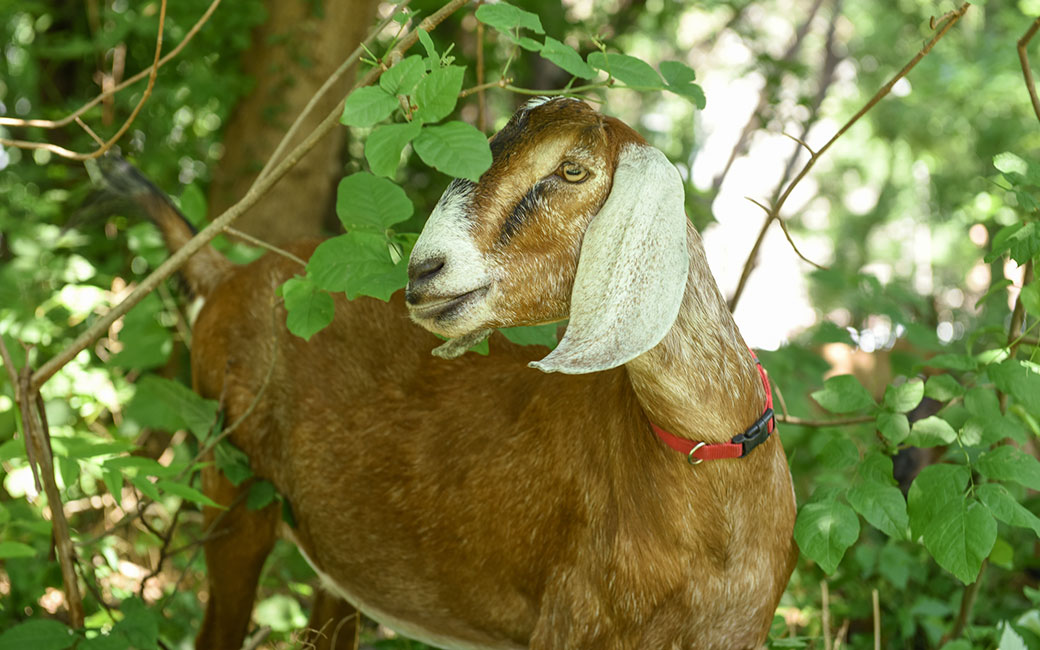Goats return to the Glen this week—here’s what to expect
Why goats make the perfect partner in the Glen Arboretum’s restoration
By Rebecca Kirkman on September 16, 2019

On Tuesday and Wednesday, Towson University welcomes a herd of goats back to campus to munch on invasive plant species in the Glen Arboretum as part of a long-term restoration project.
It’s the sixth year the goats from Harmony Church Farm in Harford County, Maryland, have come to campus to help control the spread of non-native plants within the Glen. The 10-acre woodland is home to a stream and more than 100 species of native trees.
James Hull, botanist and professor emeritus in the Fisher College Department of Biological Sciences and member of the Glen Arboretum board of directors, has worked for more than a decade to improve the Glen by removing invasive species and planting trees native to Maryland. In the past few years, he’s led a team of student workers and volunteers to bring the number of native trees in the Glen from 30 to more than 108 species. This work creates a more nurturing ecosystem for wildlife and preserves the area as a research location for students and faculty.
Read more: University honored for dedication to campus trees by Arbor Day Foundation, Maryland DNR
Funding for the Glen restoration—including the visiting goats—comes from a BGE Green Grant and the Chesapeake Bay Trust.
The TU community looks forward to seeing the goats on campus each year. But why are they here? We talked with Hull about the restoration of the Glen, and why goats make the perfect partner for the project.
Why goats?
Originally, Hull worked with students to remove invasive plants by hand, but the team ran into ground bees and poison ivy in the process. So Hull looked for alternatives.
“I did some research and found out that goats were used for eradicating invasive species,” Hull recalls. “They do a wonderful job. Goats are browsers rather than grazers. Browsers like to eat from ankles to knees, and grazers will eat at the level of their feet. For the most part, goats prefer to eat things up above; they love to stand on their hind legs and eat or to bend down shrubs and trees to eat them.”
What are they eating?
Invasive plants in the Glen include English ivy, Japanese honeysuckle, oriental bittersweet, wineberry and multiflora rose. Nearly all of these plants make ideal snacks for the goats.
Prickly plants and stinging insects don’t bother them, either. “Wineberry is a type of raspberry that has thorns all over it, and the goats just devour it,” Hull says. “They’ll eat poison ivy and everything else.”
Why remove non-native plants?
“Invasive species take over,” explains Hull. “All you need to do is drive down the Jones Falls Expressway and look at the woods on either side—all you see there are invasive species.”
Because they aren’t native to the area, invasive species have no biological control. “Insects don’t eat them, the deer won’t eat them, and so they don’t have any natural enemies,” Hull adds. “But at the same time, they are killing off the native plants, which support a broad range of other species.”
How long will the goats stay, and what happens when they leave?
The goats are scheduled to be on campus Tuesday and Wednesday, returning back to their farm over night. But it all depends on weather and how quickly they do their job.
“The goats will not work in the rain,” Hull says with a chuckle, recalling a prior visit to campus that was interrupted by inclement weather. “They just stand there and stare at you, refusing to eat.”
Sometimes the goats work so efficiently they head home early.
After the goats leave there’s a bit more work that needs to be done to ensure that the plants they eat don’t return. On Friday, Hull and a group of students will dig up the root balls of the plants. Later this fall, they will begin to plant native trees to replace the invasive plants that were removed.
“In October we will plant more than 600 perennial plants, then two weeks later we will be putting in 30 trees and shrubs,” Hull says.
The Glen Arboretum board of directors efforts continue to make TU’s woodland a space for research and enjoyment by the community.